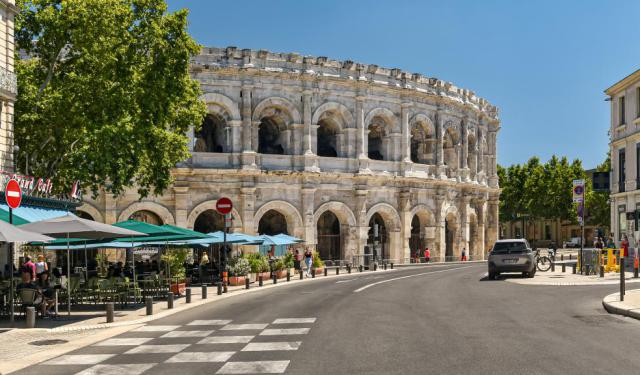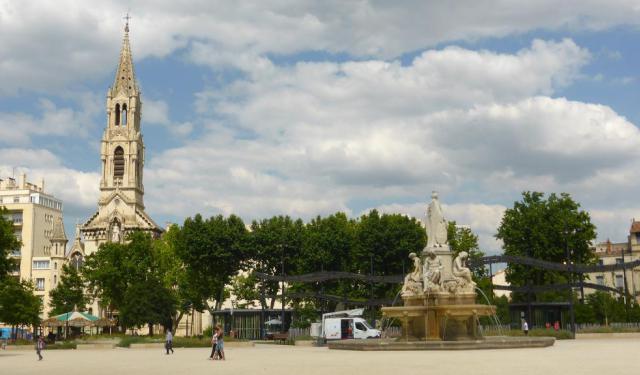
Maison Carree (Square House), Nimes (must see)
The Square House stands as a remarkable testament to Roman architecture and religious devotion in the charming city of Nîmes. This ancient Roman temple is celebrated as one of the best-preserved examples of Roman temples within the former Roman Empire's territory. It served as a mid-sized Augustan provincial temple dedicated to the Imperial cult, specifically as a caesareum.
The Maison Carrée has had a profound influence on architecture throughout history. It inspired the design of neoclassical structures such as the Église de la Madeleine in Paris, the St. Marcellinus Church in Rogalin, Poland, and, notably, the Virginia State Capitol in the United States. The Virginia State Capitol's design was the work of Thomas Jefferson, who, during his time as the Minister to France in 1785, had a stucco model of the Maison Carrée created. This temple's enduring impact extends across continents and centuries.
In recognition of its cultural significance and architectural splendor, the Maison Carrée was inscribed on the UNESCO World Heritage List in September 2023. Its historical origins date back to around 4–7 AD, when the temple was dedicated or rededicated to Gaius and Lucius Caesar, the grandsons and adopted heirs of Augustus, both of whom met untimely demises. Over the centuries, the original dedication inscription to Gaius and Lucius was lost, but in 1758, a local scholar, Jean-François Séguier, meticulously reconstructed the inscription based on the arrangement and number of holes on the front frieze and architrave, which had once held bronze letters.
The Maison Carrée embodies elements of a Tuscan-style Roman temple as described by Vitruvius, a Roman writer on architecture from the same era, albeit with the use of the Corinthian order. Elevated on a substantial podium, standing 2.85 meters high, the temple exhibits dimensions of 26.42 meters in length and 13.54 meters in width, creating a rectangular structure that is nearly twice as long as it is wide. Its imposing façade features a deep portico or pronaos that extends almost one-third of the building's total length, lavishly adorned with ornate columns and capitals. The presence of this extensive porch distinctly highlights the temple's frontal aspect, setting it apart from the designs of ancient Greek temples.
Upon entering through a grand door measuring 6.87 meters in height and 3.27 meters in width, visitors encounter the small, windowless interior, which originally housed the temple's shrine. Today, this space is used to host a film presentation that offers insights into Nîmes' rich Roman history. Although no ancient decorations remain within the cella, the Maison Carrée's architectural and historical significance continues to captivate visitors from around the world.
The Maison Carrée has had a profound influence on architecture throughout history. It inspired the design of neoclassical structures such as the Église de la Madeleine in Paris, the St. Marcellinus Church in Rogalin, Poland, and, notably, the Virginia State Capitol in the United States. The Virginia State Capitol's design was the work of Thomas Jefferson, who, during his time as the Minister to France in 1785, had a stucco model of the Maison Carrée created. This temple's enduring impact extends across continents and centuries.
In recognition of its cultural significance and architectural splendor, the Maison Carrée was inscribed on the UNESCO World Heritage List in September 2023. Its historical origins date back to around 4–7 AD, when the temple was dedicated or rededicated to Gaius and Lucius Caesar, the grandsons and adopted heirs of Augustus, both of whom met untimely demises. Over the centuries, the original dedication inscription to Gaius and Lucius was lost, but in 1758, a local scholar, Jean-François Séguier, meticulously reconstructed the inscription based on the arrangement and number of holes on the front frieze and architrave, which had once held bronze letters.
The Maison Carrée embodies elements of a Tuscan-style Roman temple as described by Vitruvius, a Roman writer on architecture from the same era, albeit with the use of the Corinthian order. Elevated on a substantial podium, standing 2.85 meters high, the temple exhibits dimensions of 26.42 meters in length and 13.54 meters in width, creating a rectangular structure that is nearly twice as long as it is wide. Its imposing façade features a deep portico or pronaos that extends almost one-third of the building's total length, lavishly adorned with ornate columns and capitals. The presence of this extensive porch distinctly highlights the temple's frontal aspect, setting it apart from the designs of ancient Greek temples.
Upon entering through a grand door measuring 6.87 meters in height and 3.27 meters in width, visitors encounter the small, windowless interior, which originally housed the temple's shrine. Today, this space is used to host a film presentation that offers insights into Nîmes' rich Roman history. Although no ancient decorations remain within the cella, the Maison Carrée's architectural and historical significance continues to captivate visitors from around the world.
Want to visit this sight? Check out these Self-Guided Walking Tours in Nimes. Alternatively, you can download the mobile app "GPSmyCity: Walks in 1K+ Cities" from Apple App Store or Google Play Store. The app turns your mobile device to a personal tour guide and it works offline, so no data plan is needed when traveling abroad.
Maison Carree (Square House) on Map
Sight Name: Maison Carree (Square House)
Sight Location: Nimes, France (See walking tours in Nimes)
Sight Type: Attraction/Landmark
Guide(s) Containing This Sight:
Sight Location: Nimes, France (See walking tours in Nimes)
Sight Type: Attraction/Landmark
Guide(s) Containing This Sight:
Walking Tours in Nimes, France
Create Your Own Walk in Nimes
Creating your own self-guided walk in Nimes is easy and fun. Choose the city attractions that you want to see and a walk route map will be created just for you. You can even set your hotel as the start point of the walk.
Ancient Roman Ruins in Nimes
Nicknamed “the French Rome,” the southern French town of Nimes is indeed the most Roman city outside of Italy. In large part, this is due to a wealth of architectural monuments that have remained here since the Roman era. Some ruined and some well-preserved, they offer a captivating glimpse into the ancient history stretching back to the early days of Roman expansion.
A true testament to... view more
Tour Duration: 2 Hour(s)
Travel Distance: 3.7 Km or 2.3 Miles
A true testament to... view more
Tour Duration: 2 Hour(s)
Travel Distance: 3.7 Km or 2.3 Miles
Nimes Introduction Walking Tour
Dubbed the most Roman city outside Italy, Nimes, a small city in Southern France, is steeped in history that harks back to the days of the mighty Roman Empire.
The name itself holds clues to the city's origin, reflecting Celtic roots and connection with the local god, Nemausus, associated with a healing spring.
The hill of Mount Cavalier, once an oppidum, served as the birthplace of... view more
Tour Duration: 1 Hour(s)
Travel Distance: 1.8 Km or 1.1 Miles
The name itself holds clues to the city's origin, reflecting Celtic roots and connection with the local god, Nemausus, associated with a healing spring.
The hill of Mount Cavalier, once an oppidum, served as the birthplace of... view more
Tour Duration: 1 Hour(s)
Travel Distance: 1.8 Km or 1.1 Miles


